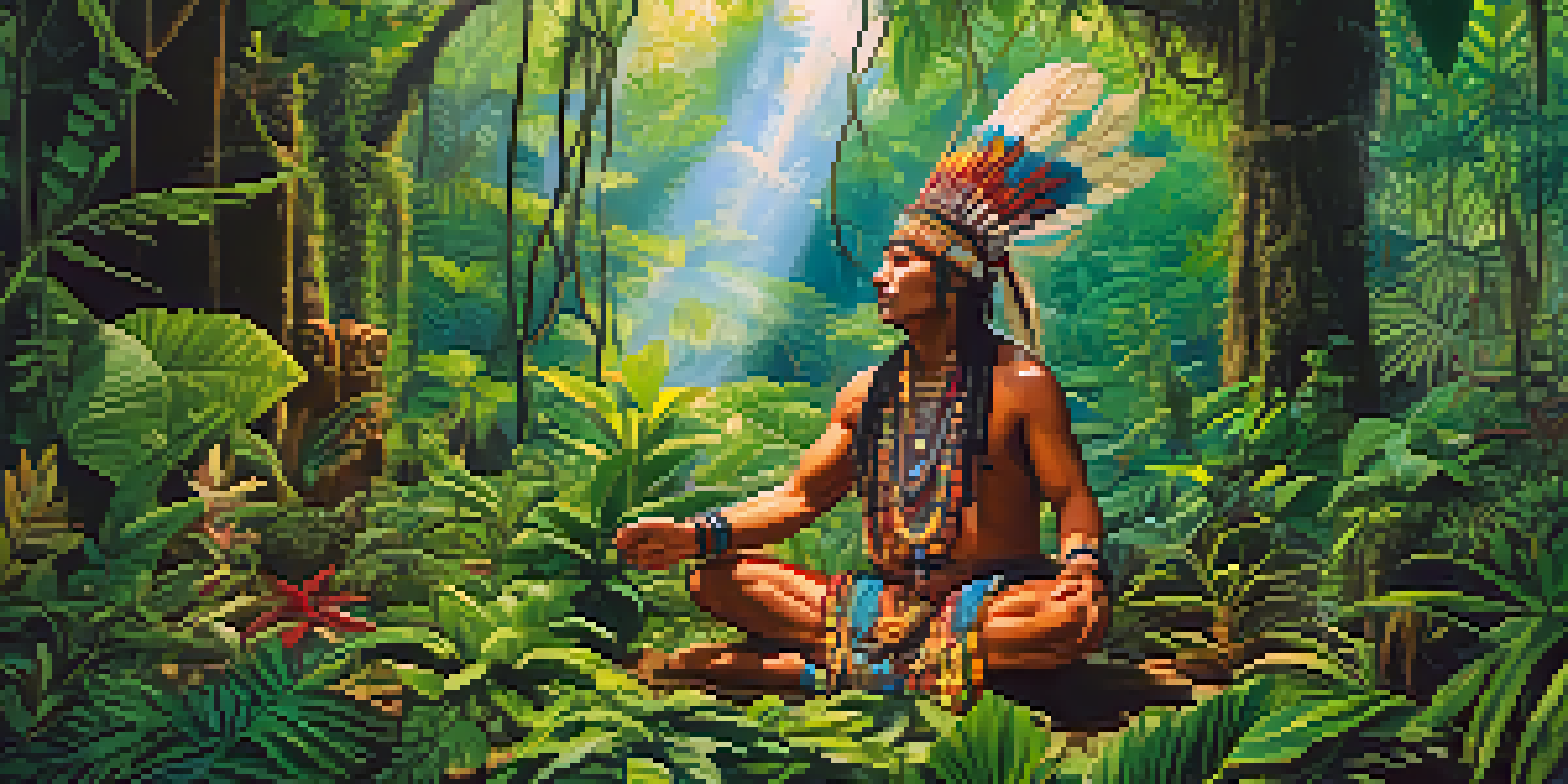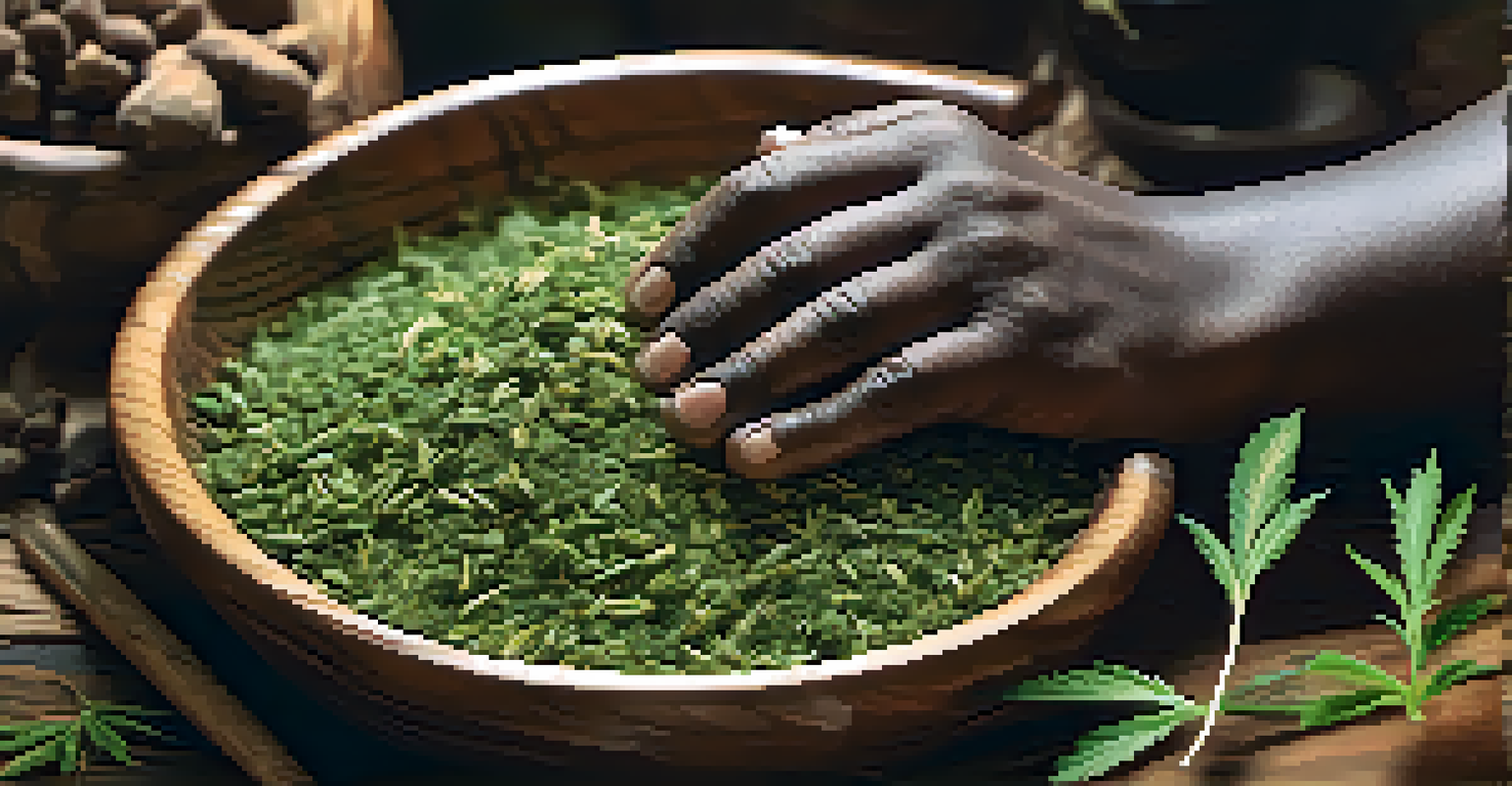Marijuana's Integration in South American Traditional Healing

A Brief History of Marijuana in South America
Marijuana has a long and storied history in South America, dating back centuries when indigenous tribes utilized its medicinal properties. Early records suggest that the plant was revered not just for its psychoactive effects but also for its role in healing rituals. Various cultures, from the Andean highlands to the Amazon rainforest, incorporated marijuana into their traditional medicine practices, using it to treat ailments ranging from pain to anxiety.
The greatest medicine of all is teaching people how not to need it.
As colonization began, the perceptions of marijuana shifted, often stigmatizing its use. However, many traditional healers continued to embrace the plant, integrating it into their practices despite external pressures. This resilience highlights how deeply rooted marijuana is in the cultural fabric of South America, serving as a testament to its importance in local healing traditions.
In recent years, there has been a resurgence of interest in these ancient practices, as modern science begins to validate the therapeutic benefits of marijuana. This renewed focus encourages a closer examination of how traditional methods can coexist with contemporary medicine, paving the way for a holistic approach to health.
Traditional Healing Practices Involving Marijuana
In various South American cultures, traditional healers known as shamans play a crucial role in utilizing marijuana for healing. They often prepare herbal mixtures, infusions, or even smoke the plant during ceremonies to connect with spiritual realms and invoke healing energies. This practice reflects the belief that physical ailments may have spiritual roots, necessitating a dual approach to treatment.

For instance, in the Amazon basin, some tribes use marijuana to alleviate chronic pain and anxiety. They believe that the plant not only treats physical discomfort but also helps individuals confront emotional and psychological issues. This holistic approach is vital in indigenous healing, where the mind and body are viewed as interconnected.
Marijuana's Cultural Roots
Marijuana has been integral to South American indigenous cultures for centuries, serving both medicinal and spiritual purposes.
Moreover, these traditional practices often involve community participation, emphasizing the social aspect of healing. Sharing experiences and support within a group setting can enhance the healing process, allowing individuals to feel a sense of belonging while addressing their health challenges.
The Role of Shamans in Healing with Marijuana
Shamans are often seen as the bridge between the physical and spiritual worlds, and their role in healing with marijuana is both respected and vital. These practitioners possess extensive knowledge about local flora, including marijuana, and understand how to harness its properties effectively. Their expertise is not merely academic; it is deeply intertwined with cultural beliefs and practices.
In every walk with nature, one receives far more than he seeks.
During healing ceremonies, shamans may use marijuana as a tool for divination, helping individuals uncover underlying issues that contribute to their ailments. The shaman's use of marijuana often involves chanting, drumming, and other rituals that create a sacred space for healing. This combination of physical and spiritual practices can lead to profound transformations for those seeking help.
Additionally, the shaman's presence provides reassurance to individuals, fostering trust and encouraging them to open up about their struggles. This relational aspect of healing can be just as important as the medicinal properties of marijuana, highlighting the necessity of a supportive environment in the healing journey.
Modern Research on Marijuana’s Healing Properties
With the increasing acceptance of marijuana in many parts of the world, modern research has started to explore its medicinal properties more closely. Studies indicate that compounds found in marijuana, such as cannabinoids, may help alleviate symptoms of various health conditions, including chronic pain, anxiety, and PTSD. This scientific validation lends credibility to the traditional practices of South American healers.
Researchers are particularly interested in the entourage effect, which suggests that the various compounds in marijuana work together synergistically to enhance therapeutic effects. This idea aligns with how traditional healers utilize the entire plant, often mixing it with other herbs for a more holistic treatment. Such findings could potentially reshape how we view and utilize marijuana in both traditional and modern medicine.
Modern Science Validates Healing
Recent research supports the therapeutic benefits of marijuana, aligning with traditional healing practices and emphasizing its holistic applications.
However, it's essential to approach this research with caution, as the effects of marijuana can vary widely among individuals. This variability emphasizes the importance of personalized treatment, a principle that traditional healers have long understood and practiced.
Challenges in Integrating Traditional and Modern Medicine
While the integration of traditional healing practices and modern medicine shows promise, it is not without challenges. One significant hurdle is the stigma surrounding marijuana, which can hinder its acceptance in mainstream healthcare settings. As a result, many individuals may feel reluctant to discuss their use of marijuana for healing, fearing judgment or misunderstanding from healthcare providers.
Furthermore, the regulatory landscape surrounding marijuana varies significantly across countries in South America, creating confusion about its legality and use. This inconsistency can limit access to marijuana for those who might benefit from it in a therapeutic context. It highlights the need for clearer policies that respect both traditional practices and modern scientific research.
Despite these challenges, there is a growing movement advocating for the inclusion of traditional healing methods in healthcare systems. By fostering a dialogue between traditional healers and medical professionals, we can work towards a more integrated approach that respects cultural practices while ensuring patient safety and well-being.
Cultural Significance of Marijuana in South America
Marijuana holds deep cultural significance in many South American societies, often intertwined with identity, spirituality, and community. For many indigenous groups, the plant is not just a healing tool but also a sacred element that plays a role in rituals and ceremonies. This cultural connection adds layers of meaning to its use, emphasizing the importance of context in understanding marijuana's role in healing.
In addition to its medicinal uses, marijuana is often featured in social gatherings and celebrations, reinforcing its place in the cultural landscape. Whether used in traditional ceremonies or shared among friends, the plant serves as a medium for connection and communal bonding. This aspect of marijuana use reflects a broader perspective on health that encompasses emotional and social well-being.
Challenges in Healing Integration
Stigma and regulatory inconsistencies present significant obstacles to combining traditional and modern medical practices involving marijuana.
Understanding the cultural significance of marijuana is essential for anyone looking to engage with these practices respectfully. Acknowledging its role in the lives of those who use it for healing helps bridge the gap between traditional and modern perspectives, fostering a deeper appreciation for the rich tapestry of South American healing traditions.
Future Directions for Marijuana in Healing Practices
As society progresses, the future of marijuana in healing practices appears promising, particularly in South America. The increasing recognition of its medicinal benefits may lead to more comprehensive studies and a better understanding of how to harness its properties effectively. This potential lays the groundwork for integrating traditional knowledge with modern scientific research, creating a richer tapestry of healing options.
Furthermore, with the rise of holistic health approaches, there is an opportunity to promote collaboration between traditional healers and medical professionals. Such partnerships could enhance treatment options for patients, offering a more well-rounded approach to health and wellness that honors both cultural practices and scientific evidence.

Ultimately, the journey of marijuana in healing practices is just beginning. By respecting and valuing traditional knowledge while embracing modern research, we can pave the way for a future where diverse healing methods coexist, offering individuals more choices in their paths to health and recovery.